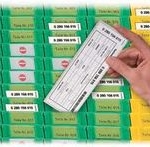Kanban – Using in wood and furniture industry
Why, when and how to use the Kanban in the wood and furniture industries?
The main goal of Kanban is to pilot simply and visual the production and delivery of parts. The manufacturer of furniture and carpentry work increasingly by order. For this type of management, they often use ERP business, integrating all processes from design to delivery : all the components are assigned to an order and are plotted throughout the cycle.
This management system is effective in the management of products by order, but is heavy for the management of common components, and consumed regularly at a fairly high level. To simplify management and reduce costs, it is interesting to manage these components with Kanban wich is a pull flow tool wich allows to implement a process of continuous improvement.
The method is explained in a specific chapter. Here we will dedicate ourselves to take three examples which are good bases to deploy in a furniture manufacturing unit :
Hinges – Handles – Strips
These three products can be managed with Kanban, because in general, they have a regular and consistent use.

How to use it?
Different steps are required for the deployment of the method :
- Define the process to connect by Kanban loops
- Define the tools pull system: supermarket, double tray, kanban, milkman tour
- Analyze and forecast consumption to determine the mean and variability
- Calculate the number of kanban and size supermarkets
- Validate container size, frequency of delivery, the feasibility
- Start the system, implement continuous improvement
Sizing a Kanban loop
N = ((D + S) x (Q / t)) / Q
- N = Number of Kanban
- D = Deadline for return of a Kanban sent to the supplier (in hours)
- S = Deadline for safety (in hours), depending on the imperfections in the process
- Q = Daily amount
- t = Daily working time (in hours)
- C = Capacity of a container
Hinges
- Manufacture of furniture 100 per day – Consumption of 150 hinges
- Hinges in box of 50
- 1 milkman run per dy at 10h00 —> delay return of Kanban 8 hours
- Timetable : 8 hours per day – 08h00:12:00 – 13h00:17:00
- Safety delay 2h00
N = ((8 + 2) x (150/8)) / 50 = 3.75
N = 4
Handles
- Manufacture of furniture 100 per day – Consumption of 180 handles
- Handles in box of 10
- 2 milkman run per day at 10h00 and 15h00 —> return time kanban 4 hours
- Timetable : 8 hours per day – 08h00:12:00 – 13h00:17:00
- Safety delay 1h00
N = ((4 + 1) x (180/8)) / 10 = 11.25
N = 12
Strips
- Manufacture of furniture 150 per day – Consumption of 300 strips – 4 dimensions
- A = 40% 120 strips – B = 30% 90 strips – C = 20% 60 strips – D = 10% 30 strips
- Strips manufactured in batches of 100 and stored by 100 along the assembly line
- 1 production by wek
- Timetable : 8 hours per day – 08h00:12:00 – 13h00:17:00
- A = (40 x (120/8)) / 100 = 6 –> A = 6
- B = (40 x (90/8)) / 100 = 4.5 –> B = 5
- C = (40 x (60/8)) / 100 = 3 –> C = 3
- D = (40 x (30/8)) / 100 = 1.5 –> D = 2
Kanban label
Posting :
- The fee needs downstream to the upstream
- The upstream produces only what was taken
- Only good products are delivered
- Kanban always accompany Products
- The number of kanban is continuously decreasing (seeking to improve the process to reduce safety dely and the time between 2 supplies)
Download tool sheet about Kanban.

